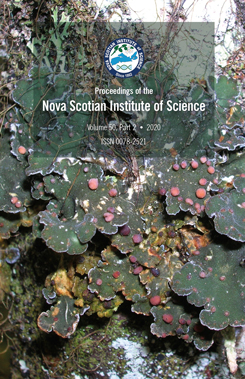Diversity, abundance and size structure of fishes and invertebrates captured by an intertidal fishing weir at Bramber, Minas Basin, Nova Scotia
DOI:
https://doi.org/10.15273/pnsis.v50i2.10003Abstract
Capturing fish using a weir or trap on the intertidal flats of the Bay of Fundy was developed by native Mi‘kamaq who later taught the method to the European settlers. Between 1800-1910 fish weirs were a significant part of the important American shad fishery in the inner Bay of Fundy before the collapse of the northwest Atlantic population from pollution and damming of major spawning rivers in the United States. Weirs remain an important segment of the Minas Basin fisheries but now the largest commercial catches consist of Atlantic herring, gaspereau and flounders. Studies on the fishes captured in Minas Basin weirs were published in 1852, 1924, 1984 and 2014, but all lacked a sampling intensity which would fully describe the diversity, abundance and size structure of the catch. An intertidal weir at Bramber, Minas Basin was surveyed during April-July, 2017 where catches were examined at each low tide. The weir was constructed on the intertidal flat during early April after Minas Basin cleared of drift ice. During the study period mean daily tide range was 10.46 m with a maximum spring tide range of 13.72 m. A total of eight neap and eight spring tide cycles were observed. Daily water temperature of Minas Basin was 8.0 C° during late May and increased to a maximum of 21.4 C° in late July. Fish and invertebrate collections began on April 10 and continued daily until July 22 when water temperatures in the trap became too warm for by-catch species to survive (+25 C°). During the study period an estimated total of 674,402 fishes consisting of 45 species were captured and of these 57,950 were measured. The most abundant fishes observed were gaspereau (alewife and blueback herring 51.9%), rainbow smelt (13.9%), Atlantic herring (13.0%) and tomcod (10.1%). Other commonly captured fishes were American shad, skate (little and winter), winter flounder, windowpane flounder, striped bass, mackerel and Atlantic sturgeon. A total of 18,511 invertebrates were captured and counted. The most abundant were long-fin squid (13.8%) and crustaceans (rock crab, lady crab; 84.0%).
Keywords: Bay of Fundy; Canada; Clupeidae; commercial fishing; temperatures; tides


